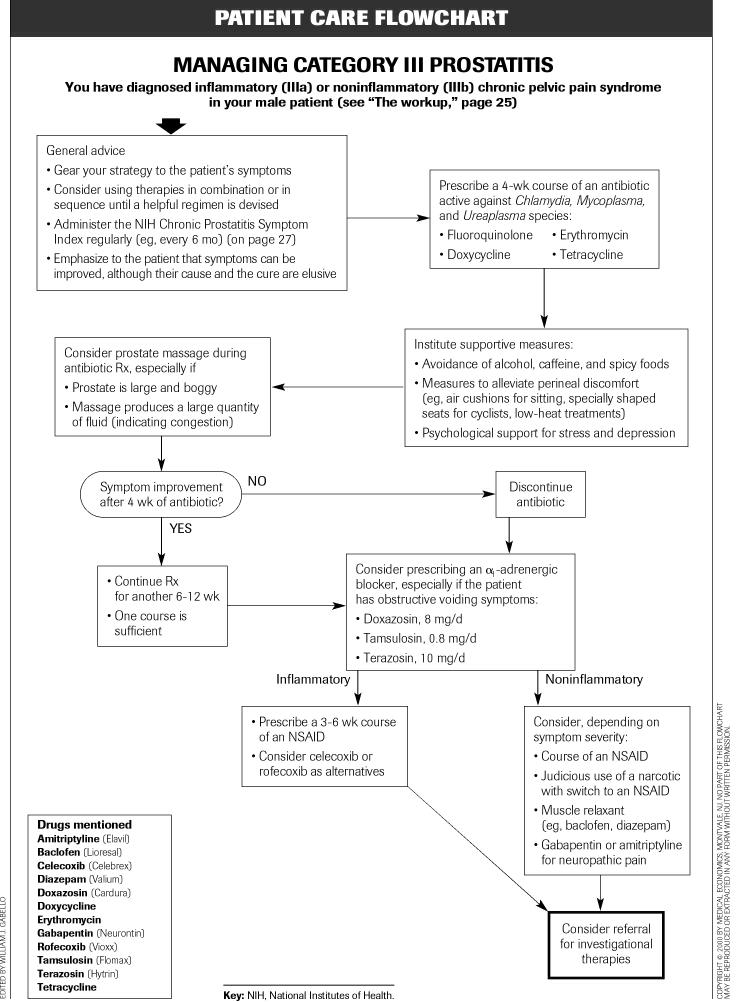|
Chronic prostatitis can be cured Gabe Mirkin, M.D. 8307 - 4/12/00 Prostate infections are extremely difficult to diagnose and treat because most doctors do not order the right tests and even when they make the correct diagnosis, they often fail to treat the condition long enough or they fail to treat infected partners. Researchers at UCLA report curing men with chronic prostatitis by massaging the prostate 1 to 3 times a week and giving men culture-specific antibiotics (1). I am amazed that so many men with chronic prostatitis go to urologists and are never cured. One in four men may have chronic prostatitis characterized by a feeling that they have to urinate all the time, discomfort during urination, terrible discomfort when the bladder is full and having to get up many time each night to urinate. If you have these symptoms, go to a urologist. Urine tests and cultures are almost always normal in men with prostate infections. An evaluation for prostatitis should include a PSA blood test to screen for cancer. The only dependable ways to diagnose prostate infection is to massage the prostate, collect secretions and see lots of white blood cells in the secretion under a microscope or to order a semen culture. If he can't get secretions, he should check your urine afterwards for white blood cells. Even if he doesn't see white blood cells, you still could have an infection. Telling you that you have benign prostate enlargement means that you have an incurable condition that is treated with muscle relaxants and drugs to block derivatives of male hormones, that cure nothing and help relieve symptoms only a little. Your best bet is to take antibiotics for several months. Most urologists do not order semen cultures because they claim that they are always contaminated with germs from the skin. Recent studies from Cornell and Mexico City show that they are wrong (2,3). Most men collect semen cultures from the vagina or mouth which always is contaminated. If the patient is asked to shower and clean himself with soap and water, then collect the specimen with his hands and then let it squirt into the culture jar without touching it, the culture is very dependable. Prostate infections are extraordinarily difficult to cure because antibiotics do not accumulate in high concentrations in the prostate. So most men have to take appropriate antibiotics for many months and their partners have to take the same antibiotics for a much shorter duration. I often prescribe a combination of Cipro and doxycycline for several months. If you do not feel much better by six weeks, you may need to ejaculate frequently or find a kind urologist who will agree to massage your prostate at least once a week while you take the antibiotics. UCLA researchers report that 40% were cured, 20% were initially cured and then had a recurrence perhaps because the partner was not treated, 21% were improved and only 21% had no improvement. All the men who had bacteria in their semen cultures produced sterile specimens after treatment. Many urologists feel that prostatitis is not caused by bacteria, but doctors do not have readily available dependable tests to diagnose chlamydia, mycoplasma and ureaplasma because these bacteria live inside of cells and cannot be cultured by methods that are used for other bacteria. Recent research shows that 30% of mycoplasmas are resistant to tetracyclines and may be curable only with high doses of intravenous antibiotics, but urologists rarely use intravenous antibiotics because they feel that they have to have a positive culture for a bacteria (4). So the present epidemic of resistant prostatitis may be due to the fact that men with that condition are not being treated adequately for their problem. 1) DA Shoskes, SI Zeitlin.Use of prostatic massage in combination with antibiotics in the treatment of chronic prostatitis.Prostate Cancer and Prostatic Diseases, 1999, Vol 2, Iss 3, pp 159-162.Address:Shoskes DA, Harbor UCLA Med Ctr, Div Urol, Box 5, 1000 W Carson St, Torrance,CA 90502 USA. 2) FY Kim, M Goldstein. Antibacterial skin preparation decreases the incidence of false-positive semen culture results. Journal of Urology 161: 3 (MAR 1999):819-821. Address FY Kim, Cornell Univ, Med Ctr, New York Hosp, Dept Urol, 525 E 68th St, Box 94, New York, NY 10021 USA. 3) CA VillanuevaDiaz, GA FloresReyes, M BeltranZuniga, M EchavarriaSanchez, JF.International Journal of Fertility and Womens Medicine, 1999, Vol 44, Iss 4, pp 198-203. MEXICO 4) MM Collins, FJ Fowler, DB Elliott, PC Albertsen, MJ Barry. Diagnosing and treating chronic prostatitis: Do urologists use the four-glass test? Urology, 2000, Vol 55, Iss 3, pp 403-407. Address: Collins MM, Massachusetts Gen Hosp, Gen Med Unit, Med Serv, 50 Staniford St, 9th Floor, Boston,MA 02114 USA 5) JN Krieger, R Jacobs, SO Ross. Detecting urethral and prostatic inflammation in patients with chronic prostatitis. Urology, 2000, Vol 55, Iss 2, pp 186-191. Health Reports from The Dr. Gabe Mirkin Show and DrMirkin.com Transcripts of segments of The Dr. Gabe Mirkin Show are provided as a service to listeners at no charge. Dr. Mirkin's opinions and the references cited are for information only, and are not intended to diagnose or prescribe. For your specific diagnosis and treatment, consult your doctor or health care provider. http://www.drmirkin.com/men/8307.html
Patientcare, managing categori III prostatits
Ovanstående flödeschema ingår i artikeln ”Helping patients cope with chronic prostatitis”, som är författad av tre av USA´s ledande forskare inom området: Keith B. Armitage (infektionsläkare), J. Curtis Nickel (urolog) och Daniel Shoskes (urolog). I artikeln som är publicerad i Patientcare april 2000 så understryker man att smärtorna vid kronisk prostatit för vissa drabbade kan jämföras med det kroniska smärtsyndrom, som uppträder sekundärt vid prostatacancer och att narkotiska preparat därför är nödvändiga. Hela artikeln är mycket läsvärd och finns på: http://www.patientcareonline.com (Patientcare april 30, 2000)
Tillbaka till Behandling (på sidan om Prostatasjukdomarna)
|

